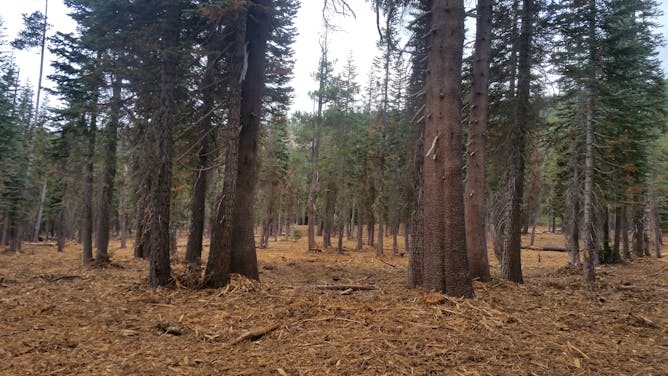|
|
|
|
We sent today’s newsletter earlier without featuring our lead article, so we are sending it again. We apologize for the mistake.
There’s been little respite for California in this record-setting wildfires season, with more hot weather forecast this week. State agencies, scientists and conservation groups increasingly agree that California needs to vastly scale up forest restoration efforts – thinning trees and clearing decades of accumulated brush that fuels huge blazes.
But as University of California Merced engineers Roger Bales and Martha Conklin explain, that won’t be easy or cheap. These projects can cost up to $4,000 per acre, and California needs to treat as much as 10 million acres. Bales and Conklin see local partnerships and innovative financing as the best hopes for taking on this mammoth job.
Also today:
|
Jennifer Weeks
Environment + Energy Editor
|

|
|

A mixed-conifer forest in the central Sierra Nevada after restoration, with unthinned forest in the background.
Roger Bales
Roger Bales, University of California, Merced; Martha Conklin, University of California, Merced
Restoring western forests – thinning out small trees and dead wood – is an important strategy for reducing the risk of massive wildfires. But these projects aren't fast, easy or cheap.
|
Health
|
-
Wanyun Shao, University of Alabama
Research and a recent campaign rally show how political leaders' rhetoric can shape risk perceptions among their loyal followers.
|
|
Politics/Election '20
|
-
John E. Finn, Wesleyan University
A scholar of militia movements describes the 'peculiar' -- and erroneous -- principles that right-wing militias subscribe to, including believing themselves to be defenders of the Bill of Rights.
-
Calvin Schermerhorn, Arizona State University
In the 1860's, the Supreme Court was a 'partisan creature' and President Lincoln and the Republican Party remade it so that it reflected the party's priorities.
-
Richard Briffault, Columbia University
Some 44,000 people – about one-hundredth of 1% of the US population -- have given $10,000 or more each to this election. So much money from so few donors inevitably distorts the political process.
-
Lisa García Bedolla, University of California, Berkeley
Strangers used to call and stop by; now the most effective way to get people to vote involves getting groups of friends and neighbors to pressure each other to participate in democracy.
|
|
Economy + Business
|
-
William Hauk, University of South Carolina
Some economists have begun to compare the current recession and recovery with a 'K,' while others see a 'V.' Which is it, and what does it mean?
|
|
Ethics + Religion
|
-
Ceri Hughes, University of Wisconsin-Madison
Trump uses more religious terms in his set-piece addresses than any other president in the last 100 years.
|
|
Education
|
-
Beth D. Benedix, DePauw University; Steven Volk, Oberlin College and Conservatory
To secure a better future, small liberal arts colleges must focus on providing more opportunities for upward mobility, authors of a new book about the pandemic's effect on the colleges say.
-
Amber M. Simpson, Binghamton University, State University of New York; Peter N. Knox
A new hands-on learning program helps families with young children build their engineering skills.
|
|
Arts + Culture
|
-
Jeffrey Arnett, Clark University
The U.S. was an outlier in the 20th century. It’s been typical throughout human history, and even today, it’s common practice in most of the world.
|
|
Science + Technology
|
-
Meghan E. Rebuli, University of North Carolina at Chapel Hill
A new study is the first to identify sex differences in inflammation and immune cell activation in response to SARS-CoV-2 infection, which causes COVID-19.
|
|
From our international editions
|
-
Kristin M Bakke, UCL; Gerard Toal, Virginia Tech; John O’Loughlin, University of Colorado Boulder
Armenia and Azerbaijan are fighting over the contested territory of Nagorno-Karabakh. But what do the people who live there want?
-
Catherine Clase, McMaster University; Edouard Fu, Leiden University; Juan Jesus Carrero, Karolinska Institute
Epidemiologists reviewed 25 studies of cloth face masks. Here’s what they found out about how well they work, why they work, who they protect and why the mosquito and chain-link fence analogy is wrong.
-
John Hawkins, University of Canberra
For their work on auctions and 'the winner's curse', Stanford neigbhours Paul Milgrom and Robert Wilson have won the 2020 Nobel Prize for economics.
|
|
| |
| |
| |
| |
| |
| |
|
|
|
|
|
|
|